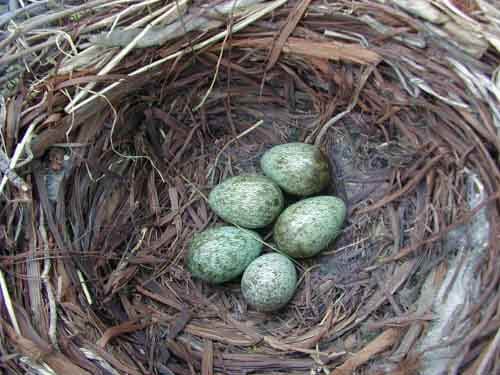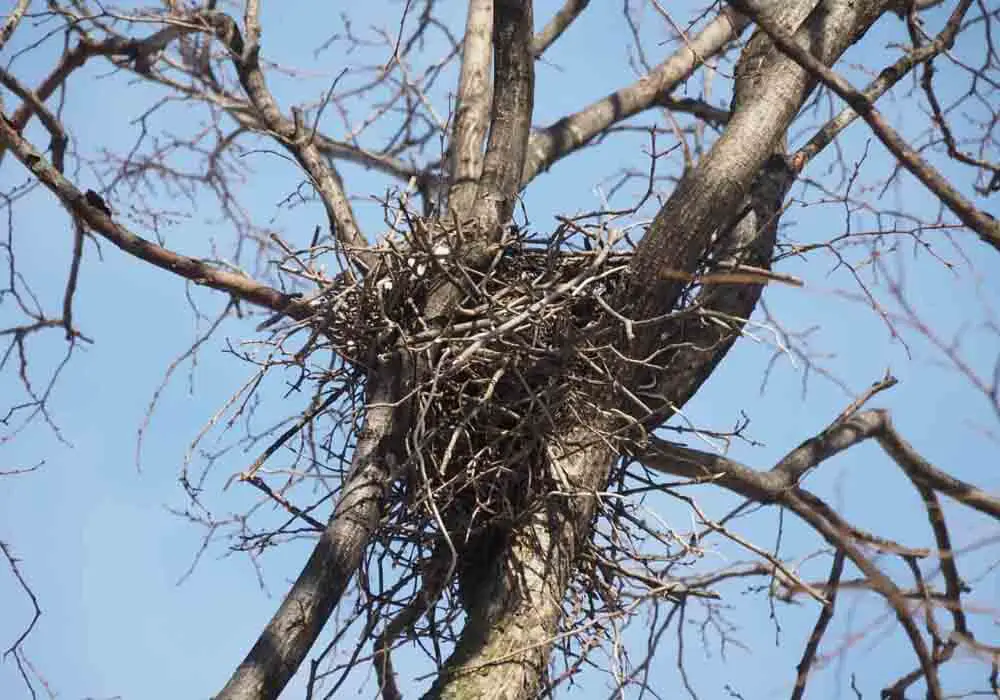Crow Nesting Habits and Behavior
A crow is a large group of black birds from the passerine family (known for perching). Although their ultimate nesting goal is the same as other bird groups, which is to prepare for arriving offspring, crow nesting habits and behavior differ. Even within the genus, various species don't nest the same way.
Most crow species arrive at nesting grounds early for the breeding season. The parents then build and place their nests up to 60 feet (18.3 meters) high on tall trees. After weeks, their offspring finish development and fly away. Hence, they also abandon the nests, sometimes to raise another brood.
Continue reading this article to learn all about crow nesting habits and behavior. I will discuss their season (thus, the best time to spot crow nests), when they will contain eggs, how long crows stay in the nest, and lots more.

When Is Crow Nesting Season?
Crows are one of the most widespread birds, with at least one species native to every habitable continent. Although various environmental factors influence each species’ nesting season worldwide, they always prefer periods when food and nesting materials are abundant.
Crow nesting season starts in February and runs till May in the United States. Although they won't begin laying and incubating new eggs until April, building nests earlier helps them secure the best tree spots. Besides, it takes many days to build a nest successfully, so starting on time is essential.
Like the American crow, those from South Asia, such as Indian jungle crows, also nest from February through May. It also takes 8 to 14 days to complete the nest construction for the breeding season.
Others, like the house crow, Jamaican crow, and little crow, also nest between February and June.
However, some in Africa and other Asian regions can nest in later months of the year. For example, the white & black pied crow typically lays eggs from August to November. Cape crows (also from Africa) build nests from December through January.
Hooded crows' nesting season is around late February in the Persian Gulf region but May to June in northwest Russia.
Generally, the farther south you go, the more the seasons become relatively inconsistent.
Regardless, crows hardly spend less than a week building nests. It also rarely exceeds two weeks because the members of a mating pair work together.
When the breeding season finally kicks in, they will remain in the nest for many weeks until their young fledge and leave, connoting their experience of living independently.
What Time of Year Do Crows Lay Eggs?
A breeding pair of crows mate for life. Owing to their highly parental instincts, they don't just play around before the mating season. Instead, they build a nest in anticipation of their young, like most other birds. They instinctively time the nest-building process before they’re expected to lay their eggs.
Crows lay eggs during their breeding season, which varies by species. For example, the American crow reproduces from early April to June. However, they usually visit breeding grounds earlier to start nest-building. They’re likely lay up to two broods of 3-9 eggs each before the season is over.

On the other hand, large-billed crows in Indian plains start breeding in mid-December and can continue laying eggs till May.
On average, large-billed crows' eggs are about 1 by 1.5 inches (2.5 by 3.8 cm). They are primarily oval-shaped but somewhat pointed at one end.
The eggs can be any shade of blue-green, speckled with grey, red-brown, pale sepia, or neutral tint. Mother crows usually lay them in fours or fives.
Conversely, the American crow lays 3-6 eggs per brood. Each egg is around 1.4 to 1.9 inches (3.6 to 4.7 cm) long and about 1 to 1.2 in- (2.5 to 3.1 cm) wide.
They are usually bluish-green or olive green with blotches of brown and gray toward the large end. Their shapes vary from oval to ellipse.
Unfortunately, many predators, such as raccoons to snakes, cats, and ravens, target crow eggs. The eggs are especially susceptible to predator attacks when their parents can't defend them while they’re away looking for food.
Do Crows Return to the Same Nest?
Crows' nests may seem easy to construct because of how numerous they are on nesting grounds. However, that’s far from the case, as crows typically take at least seven days to build each nest.
Considering the challenge and time it takes to build a new nest, it’s only natural to assume that crows might want to reuse their old ones or use another pair’s old nest. Interestingly, crows don’t behave that way.
Crows don't return to the same nest during a new nesting season although they might return to the same area. They build a fresh one for a new brood, which still takes 8-14 days to complete. However, some crows reuse the materials from old nests for new ones, especially when resources are scarce.
Here are some reasons why crows return to a particular area to nest:
- Presence of tall trees/structures: Crows prefer nesting on tall open buildings or trees up to 60 feet (18.3 meters) from the ground. If they discover any location that can provide such height, they will return there the following season.
- Food abundance: Crows need to feed their developing young during the breeding season. Therefore, optimal proximity to any reliable food source is essential.
- Predator-free: Crows avoid predators attacking them or their potential eggs like other birds. If your area doesn't have such predators, you can expect crows to return there to nest unless they sense new danger.
Studies have also indicated that crows somehow prefer urbanized areas despite the noise because of the abundance of food sources.
When they return to the site, they don't search for former nests from the previous season. Instead, they look for materials to build a new one that they'll reside in throughout the current nesting period, whether night or day.

We have many fascinating articles about Crows that range from things they like, to their behaviors around humans, to their intelligence and even how to make friends with them! You can find these interesting articles listed on our Crow Facts and Info page.
How Long Do Crows Stay in the Nest?
The primary reason crows nest is to prepare a home for their offspring. Being young and inexperienced, the hatchlings need the bowl-shaped structure for warmth and security. It can take some time before they finally outgrow their parents' care and be ready to leave the nest.
Young crows stay in the nest for about three to six weeks after hatching, which takes about three weeks after being laid. The exact period varies by species, but the American crow’s nesting period is 20-40 days. The offspring may fly away initially, only to return before finally leaving.
After the fledglings leave, the parents will also vacate the breeding site, looking to produce another brood if the season isn't over or join roosts.
However, studies show that the young of some crows, especially the American crow, Hooded crow, and Carrion crow, remain with their parents much longer than 40 days. Others may leave but return due to the bird's strong family bond.
Regardless, they won't reuse their former nest once abandoned after the offspring left.
Outside of the mating season, crows join a roost and spend their nights in roost sites. These sites have some similarities to their mating nest sites. For instance, they must have easy access to food and water and be safe from predators.
Once a new nesting season begins, a breeding pair of crows, with or without their roosts, returns to their favorite nesting ground.
Their next instinct is to look for items to build the nests around, which includes potentially recycling the materials from their old nests. More than a week later, breeding begins. They lay eggs, and the cycle repeats.
What Does the Nest of a Crow Look Like?
Each clutch size of a crow contains at least three eggs that can take up sizable space. Hence, crows need a nest large enough to hold them and their eggs for incubation.
Crow's nests look like intertwined twigs outside. However, the inner cup is lined with moss, grass, fur, or flowers for softness. The size varies by species, but the outer layer can be up to 19 in (48.3 cm) in diamater and the inner one is 15 in (38 cm). Their depth can reach up to 10 in (25 cm).

When they arrive at the nesting area, they first search for a spot to place the nest. The ideal one is at least 60 feet (18.3 meters) above the ground. They like trees with large diameters, crown volumes, and densities.
Most birders have found crow nests on deciduous trees. If you haven’t seen them before, you may think the nest belongs to more giant birds.
After choosing the spot, both parents work together, with males supplying the materials and females constructing it.
The outside needs strong sticks, such as twigs, for the nest to remain sturdy on tree forks. However, they are too rigid and may crack their potential egg or injure hatchlings. That’s why parent crows place softer materials like leaves on the inner layer to keep their offspring safe.
You may find some crow nests made from long grass. They use them as alternatives to twigs, especially when they are the only materials available.
Crow Nesting Habits And Behavior...Conclusion
Crow nesting habits and behavior are among the many qualities that distinguish them from other birds. They prefer to return to a previous breeding ground due to:
- The presence of tall trees
- Availability of reliable food and water supply
- Predator-free environment
The size of a crow’s nest is larger than the bird’s size, as they consider the potential number of eggs per clutch. The parent crows and the fledglings then leave the nest after approximately nine weeks.
They typically don’t reuse any old nest they find. Instead, they build a new one from old materials like twigs, fur, and grass.
Back
To The TOP Of This Crow Nesting Habits And Behavior Page

About the Author...
Richard Worden, a dedicated bird lover for over 20 years, I love to share my in-depth knowledge and passion for birds. Read more About Me and my expertise in this field.
- We Know Birds HOME ›
- Crow Facts and Information ›
- Crow Nesting Habits and Behavior
